Best laptops 2024: Premium, budget, gaming, 2-in-1s, and more
Buying a new laptop can be an overwhelming experience, especially with so many options out there. If you fancy yourself a power user, you should pick up a laptop with discrete graphics. For general web browsing and other day-to-day tasks, we’d recommend a Chromebook. Whatever it is you’re looking for, we’ve got something for every type of buyer. Plus, we’ve personally tested every single one of the laptops below, so we know exactly how each one performs as well as how it feels.
Why you should trust us: It’s in our name. PCWorld prides itself on laptop experience and expertise. We’ve been covering PCs since 1983, and we now review more than 70 laptops every year. All of the picks below have been personally tested and vetted by our experts, who’ve applied not only performance benchmarks but rigorous usability standards. We’re also committed to reviewing PC laptops at every price point to help you find a machine that matches your budget.
PROMOTION
Squarespace: Create professional websites with ease

Squarespace makes it easier than ever to create an attractive and functional website for your own business. With tools for web design, e-commerce, customer billing and more. Save 10% with our exclusive code PCWORLD10
Get started with our 10% off dealQuick retail links to select top products:
- Best overall: Dell Inspiron 14 Plus (2024)
- Best battery life: Lenovo ThinkPad T14s Gen 6
- Best budget: Acer Aspire Go 15
- Best Chromebook: Lenovo Flex 5i Chromebook Plus
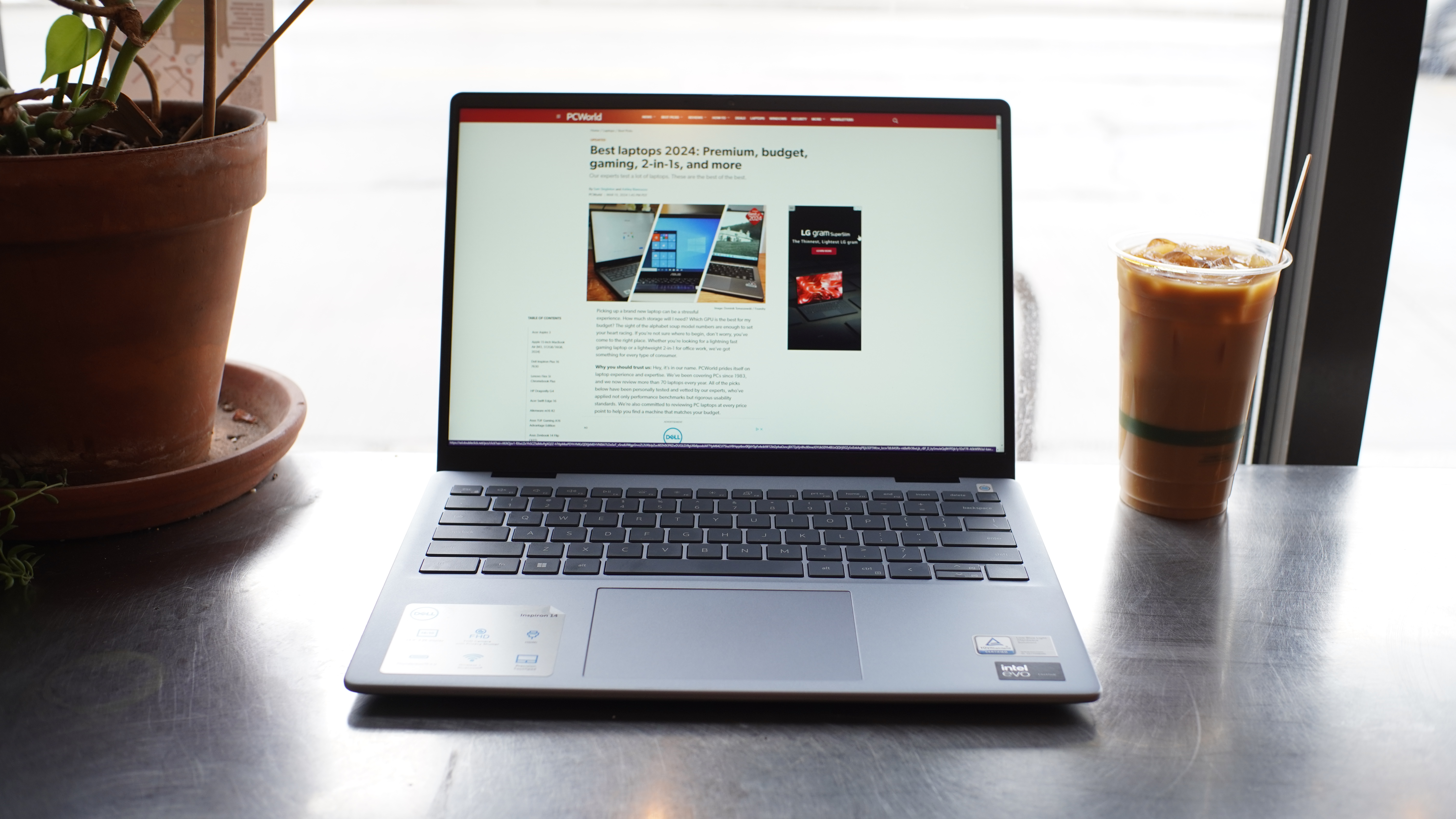
Pros
- Strong performance
- Exceptional battery life
- Wonderful typing experience
Cons
- CPU throttles under heavy loads
- No user upgrades
 $999.99
View Deal
$999.99
View Deal
 $999.99
View Deal
Price comparison from over 24,000 stores worldwide
Product
Price
Price comparison from Backmarket
$999.99 at Amazon$999.99 at Dell
Why we like the Dell Inspiron 14 Plus
$999.99
View Deal
Price comparison from over 24,000 stores worldwide
Product
Price
Price comparison from Backmarket
$999.99 at Amazon$999.99 at Dell
Why we like the Dell Inspiron 14 Plus
The Dell Inspiron 14 Plus is one of the most well-rounded laptops money can buy. It offers strong performance, exceptional battery life, and a vibrant display. The best part is that it costs about $1,000, which is a reasonable price point considering the price to performance ratio. In fact, it performed exceptionally in PCMark 10’s benchmark, according to our review. With a PCMark 10 score of 7,061, it beat out the Acer Swift Go 14, which has similar specs to the Dell, and the more expensive Lenovo ThinkPad X1 Carbon. The Inspiron 14 Plus also lasted an impressive 17 hours on a single charge, which is definitely more than a full workday or school day. You don’t have to worry about finding a wall outlet to charge up.
Who should buy the Dell Inspiron 14 PlusAnyone looking for a really good, well-rounded laptop. In addition to the impressive performance and battery life, it also has a lovely 14-inch 1400p display. According to our review, “the display is exceedingly well suited to office work and static imagery.” It has a peak brightness level of a stunning 418 nits as well as an anti-glare coating, which means you can use this laptop in different lighting environments. It may not have the prettiest design we’ve ever seen, but its hardware capabilities and astoundingly long battery life make up for the blah aesthetics.
Read our full Dell Inspiron 14 Plus review Asus Zenbook 14 OLED – Best overall runner-up
Pros
- Robust build quality
- Attractive OLED touchscreen
- Good CPU and integrated GPU performance
- Outstanding battery life
Cons
- Blah design
- Keyboard isn’t memorable
- Mediocre connectivity options
 $849.99
View Deal
Asus
$999.99
View Deal
$849.99
View Deal
Asus
$999.99
View Deal
 $1199
View Deal
Price comparison from over 24,000 stores worldwide
Product
Price
Price comparison from Backmarket
$849.99 at Walmart$999.99 at Asus$1199 at Amazon
Why we like the Asus Zenbook 14 OLED
$1199
View Deal
Price comparison from over 24,000 stores worldwide
Product
Price
Price comparison from Backmarket
$849.99 at Walmart$999.99 at Asus$1199 at Amazon
Why we like the Asus Zenbook 14 OLED
The Asus Zenbook 14 OLED wowed us with its zippy CPU performance, phenomenal battery life, and attractive OLED touchscreen display. According to our review, “movies and games look realistic and vibrant” on the 1200p OLED touchscreen, although it can be difficult to use in bright environments due to the reflective surface. It also lasted 16 hours on a single charge, which is wild! That result trumps otherwise excellent competitors like the Lenovo Slim 7 14 Gen 9 and the HP Pavilion Plus Laptop 14.
Who should buy the Asus Zenbook 14 OLEDAnyone looking for a powerful, affordable laptop with an OLED display! It’s so much more than its OLED screen, though. The build quality is quite good and day-to-day performance is zippy. Plus, you won’t have to go looking for an outlet often thanks to the long battery life. Connectivity options are a bit limited, but that’s not unusual for a laptop in this price range. Overall, it’s a great Windows machine that hits all the right marks.
Alternative option: If you’re looking for an even more affordable option, you should check out the HP Pavilion Laptop 16 ($769.99). It boasts a large 16-inch display with a taller 16:10 aspect ratio, which is perfect for scrolling through long web pages and documents. The keyboard is also spacious and easy to use, and it lasted over 18 hours on a single charge. If you’re in the market for an even longer-lasting laptop, then we’d recommend looking into the Asus Vivobook S 14 ($1,199). Not only does it come with the latest Lunar Lake CPU, but it also died at the 21 hour mark on a single charge, which is absolutely bananas.
Read our full Asus Zenbook 14 OLED review Acer Aspire Go 15 – Best budget laptop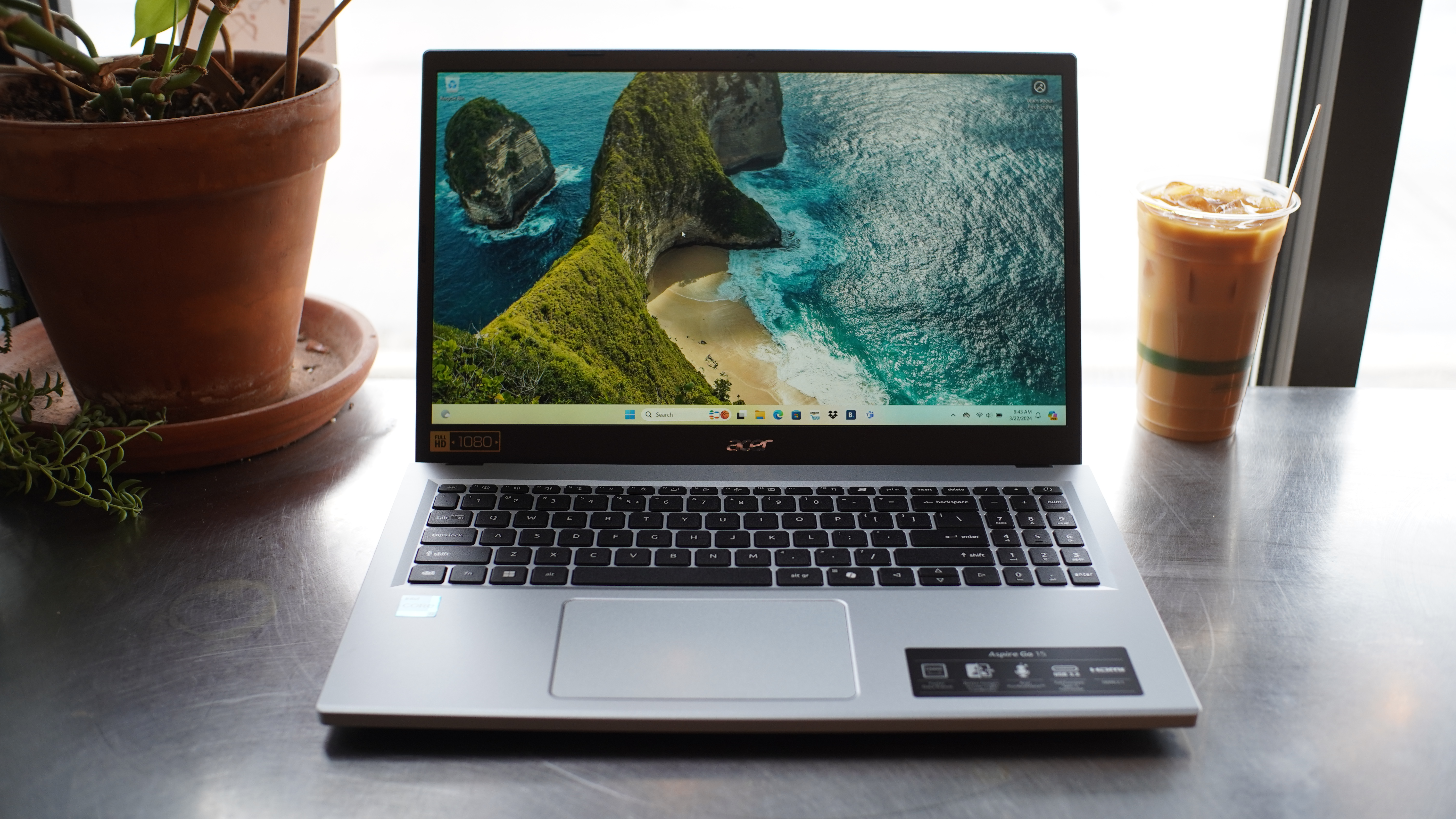
Pros
- Affordable
- Decent battery life
- Good display visibility
Cons
- Big and bulky
- Cheap build
- Limited performance
 $269.99
View Deal
$269.99
View Deal
 $299
View Deal
Price comparison from over 24,000 stores worldwide
Product
Price
Price comparison from Backmarket
$269.99 at Amazon$299 at Acer
Why we like the Acer Aspire Go 15
$299
View Deal
Price comparison from over 24,000 stores worldwide
Product
Price
Price comparison from Backmarket
$269.99 at Amazon$299 at Acer
Why we like the Acer Aspire Go 15
The Acer Aspire Go 15 offers decent performance and battery life for the price ($299). The Intel Core i3-N305 CPU is power efficient and more than capable of handling daily tasks like general browsing, checking e-mail, and so on. It also ran for almost 12 hours on a single charge, which is nothing to sneeze at. The port selection is quite good as well. You’re getting USB-A ports on either side, a 3.5mm headphone jack and Kensington lock slot on the right, and one USB-C port and one HDMI port on the left.
Who should buy the Acer Aspire Go 15Anyone looking for an inexpensive laptop with reliable day-to-day performance and good battery life. It doesn’t have all the bells and whistles you’d see on more high-end machines, but it’s both serviceable and affordable, making it a clear value. The CPU is power efficient and the battery should last you throughout the day. Plus, the 15.6-inch 1080p display is easy to see “despite its low brightness,” according to our review. It’s a solid machine, especially for those on a tight budget.
Lenovo ThinkPad T14s Gen 6 – Best battery life
Pros
- Remarkable battery life
- A great array of ports
- Sturdy, lightweight design
- High-visibility display
Cons
- Variable performance trails competitors
- A bit pricier than the competition
 $1499.76
View Deal
B&H
$1699
View Deal
Price comparison from over 24,000 stores worldwide
Product
Price
Price comparison from Backmarket
$1279.85 at Lenovo$1499.76 at Amazon$1699 at B&H
Why we like the Lenovo ThinkPad T14s Gen 6
$1499.76
View Deal
B&H
$1699
View Deal
Price comparison from over 24,000 stores worldwide
Product
Price
Price comparison from Backmarket
$1279.85 at Lenovo$1499.76 at Amazon$1699 at B&H
Why we like the Lenovo ThinkPad T14s Gen 6
The Lenovo ThinkPad T14s Gen 6 floored us with its battery life. This machine ran for almost 24 hours on a single charge, which is impressive given the smaller 58 watt-hour battery inside. This result likely stems from the lower resolution (1920×1200) display and the more power-efficient Snapdragon X Elite X1E-78-100 processor. This laptop also weighs just under 3 pounds, so it’s a great option for those who travel often.
Who should buy the Lenovo ThinkPad T14s Gen 6Anyone looking for a long-lasting laptop. It’ll last you 20+ hours on a single charge and it’s a relatively lightweight laptop that’s capable of handling light to moderate workloads. Although the display isn’t the sharpest we’ve ever seen, it still has plenty of visibility in most conditions. The port selection is also decent for a thin laptop. You’re getting two USB-A, two USB 4, one Kensington Nano lock slot, one HDMI 2.1, and a headphone/mic combo jack.
Alternative option: If you’re looking for a long-lasting 2-in-1, the Samsung Galaxy Book5 Pro 360 ($1,699) is definitely worth checking out. Not only did it last an eye-popping 23 and a half hours on a single charge, but it also has a beautiful AMOLED display and a solid chassis.
Read our full Lenovo ThinkPad T14s Gen 6 review Lenovo Flex 5i Chromebook Plus – Best Chromebook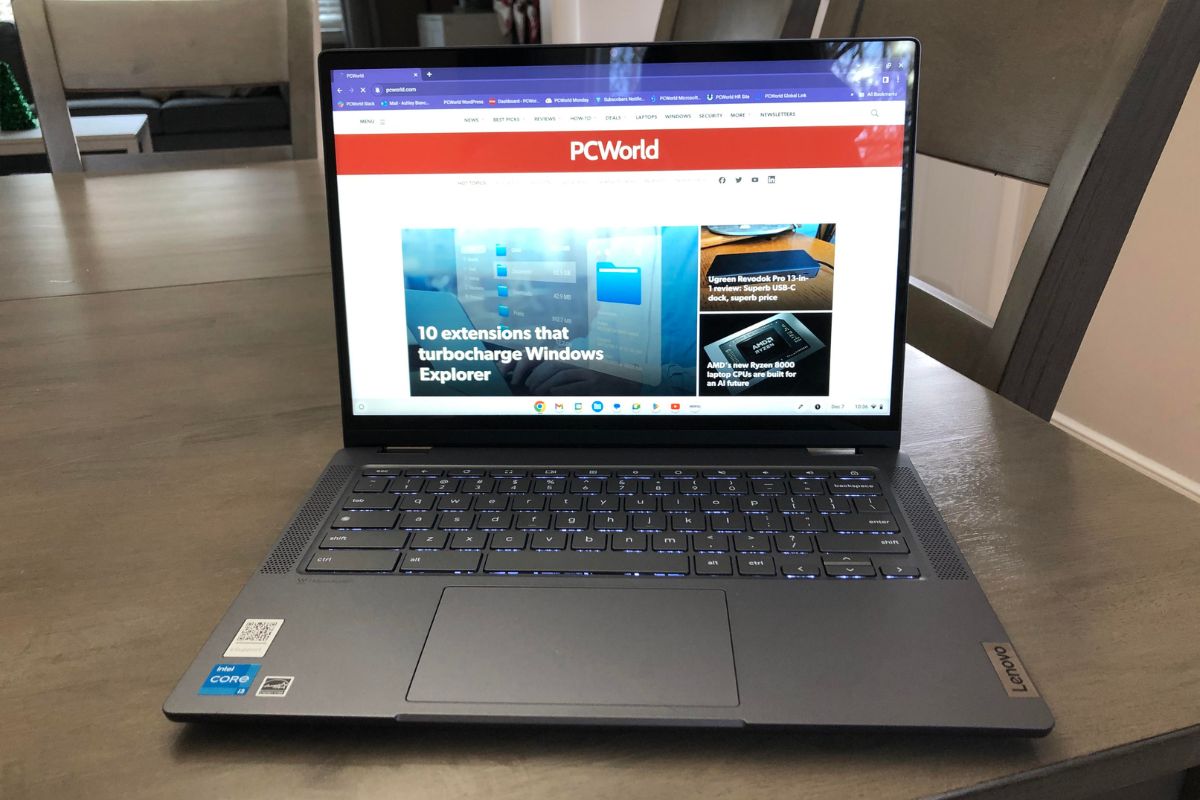
Pros
- Snappy day-to-day performance
- Versatile 2-in-1 design
- Good typing experience
Cons
- Stylus not included
- Heavier than expected
 $329
View Deal
$329
View Deal
 $479.98
View Deal
Price comparison from over 24,000 stores worldwide
Product
Price
Price comparison from Backmarket
$329 at Best Buy$479.98 at Amazon
Why we like the Lenovo Flex 5i Chromebook Plus
$479.98
View Deal
Price comparison from over 24,000 stores worldwide
Product
Price
Price comparison from Backmarket
$329 at Best Buy$479.98 at Amazon
Why we like the Lenovo Flex 5i Chromebook Plus
From the convertible design to the beautiful touchscreen, the Lenovo Flex 5i Chromebook Plus has a lot to offer, especially for under $500. The 2-in-1 design allows you to swing the screen around and use the laptop like a tablet, upping the versatility factor. You can also expect snappy day-to-day performance as well as lightning fast boot-up times.
Who should buy the Lenovo Flex 5i Chromebook PlusIf you’re looking to pick up a premium Chromebook for work or personal use, then the Lenovo Flex 5i Chromebook Plus is a fine choice. While the $499 price tag is very much in the high end when it comes to Chromebooks, we feel the overall fit, finish, and firepower make it worth the extra cash.
Alternative option: If you’re looking for a cheaper Chromebook with a bigger screen, the Acer Chromebook Plus 516 GE ($699.99) is a great option. The display measures 16 inches and it has a 2560×1600 resolution as well as a 120Hz refresh rate. According to our review, the “120Hz display is excellent and gives the laptop an edge if you’d plan to play games on a cloud gaming service that supports high refresh rates like Nvidia’s GeForce Now.” The only downside is that it’s a bit expensive for a Chromebook.
Read our full Lenovo Flex 5i Chromebook Plus review MacBook Air (M3) – Best MacBook
Pros
- Excellent battery life
- Great combination of price, features, and performance
- 256GB SSD is now two NAND chips, maintaining performance
Cons
- Expensive memory upgrades
- Dual external display support requires closed lid
 $1,299
View Deal
$1,299
View Deal
 $1299
View Deal
$1299
View Deal
 $1299
View Deal
$1299
View Deal
 $1384
View Deal
$1384
View Deal
 $1399
View Deal
$1399
View Deal
 $1499
View Deal
$1499
View Deal
 $1499
View Deal
Price comparison from over 24,000 stores worldwide
View more prices
Product
Price
Price comparison from Backmarket
$1,299 at Amazon$1299 at B&H$1299 at Best Buy
View more prices
from
Walmart ElectronicsAdoramaAppleApple United States
Close ×
Best Prices Today:
MacBook Air (M3) – Best MacBook
Retailer
Price
$1499
View Deal
Price comparison from over 24,000 stores worldwide
View more prices
Product
Price
Price comparison from Backmarket
$1,299 at Amazon$1299 at B&H$1299 at Best Buy
View more prices
from
Walmart ElectronicsAdoramaAppleApple United States
Close ×
Best Prices Today:
MacBook Air (M3) – Best MacBook
Retailer
Price
 $1,299
View Deal
$1,299
View Deal
 $1299
View Deal
$1299
View Deal
 $1299
View Deal
$1299
View Deal
 $1384
View Deal
$1384
View Deal
 $1399
View Deal
$1399
View Deal
 $1499
View Deal
$1499
View Deal
 $1499
View Deal
Price comparison from over 24,000 stores worldwide
View more prices
Product
Price
Price comparison from Backmarket
Why we like the MacBook Air (M3)
$1499
View Deal
Price comparison from over 24,000 stores worldwide
View more prices
Product
Price
Price comparison from Backmarket
Why we like the MacBook Air (M3)
The MacBook Air (M3) has a lot to offer for the $1,299 price. In fact, it received high marks across the board thanks to the 8-core CPU (M3) and the 10-core GPU. It’s capable of chewing through office work as well as casual use tasks. While performance is comparable to the MacBook Pro (M3), there is one difference: the fans or lack thereof. The MacBook Air doesn’t have any fans, which results in quieter operation before heavy-duty tasks will likely put more pressure on the chip. That said, battery life is the real star of the show here. The MacBook Air (M3) breathed its last breath at the 19 hour mark, which is perfect for those with busy schedules.
Who should buy the MacBook Air (M3)Anyone who prefers MacOS over competing operating systems. Battery life is outstanding and the laptop itself is both slim and light, weighing in at just over three pounds. The 15-inch Liquid Retina (LED) screen might be considered a step-down from the MacBook Pro’s Liquid Retina XDR (mini-LED) display, but that doesn’t mean it’s a poor screen. It still looks fantastic for day-to-day use. The $1,299 price tag is also reasonable for the performance and features you’re getting.
Read our full MacBook Air (M3) review
Alienware m16 R2 – Best gaming laptop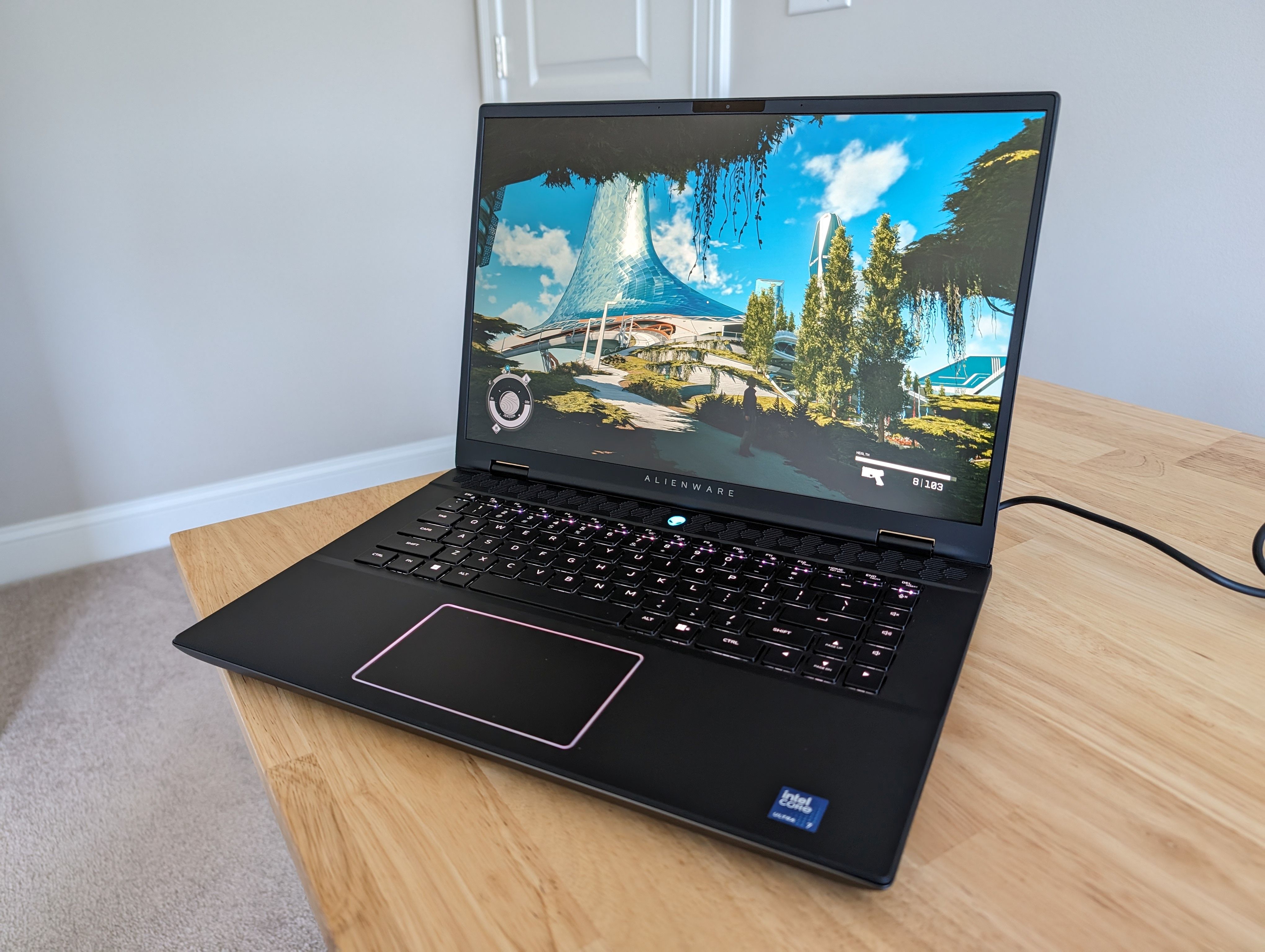
Pros
- Solid gaming performance
- Rugged build quality
- Good battery life
Cons
- Display is dimmer than we like
 $1819.99
View Deal
$1819.99
View Deal
 $1849.99
View Deal
Price comparison from over 24,000 stores worldwide
Product
Price
Price comparison from Backmarket
$1819.99 at Amazon$1849.99 at Dell
Why we like the Alienware m16 R2
$1849.99
View Deal
Price comparison from over 24,000 stores worldwide
Product
Price
Price comparison from Backmarket
$1819.99 at Amazon$1849.99 at Dell
Why we like the Alienware m16 R2
The Alienware m16 R2 delivers strong graphics performance and good battery life. This specific model comes loaded with an Intel Core Ultra 7 155H CPU and an Nvidia GeForce RTX 4070 GPU, which is nothing to sneeze at. It lasted a respectable 11 hours and fifteen minutes on a single charge and it averaged 144 frames-per-second when running the Shadow of the Tomb Raider benchmark. According to our review, it’s only “four frames-per-second slower than the Razer Blade 16,” which has an RTX 4090 GPU and a price tag of over $3,000.
Who should buy the Alienware m16 R2Anyone looking for a great gaming laptop. You’re getting strong graphics performance as well as long battery life, which is unusual for a gaming laptop, as most tend to die around the six hour mark. The 16-inch IPS display also has a resolution of 2560×1600 and a refresh rate of 240Hz, so gameplay should be nice and smooth. The picture quality is good, but it’s not an OLED panel. While it may not be the brightest or most color rich display we’ve ever seen, it’s perfectly fine for gaming. Besides, you can always plug into an external monitor if need be.
Alternative option: If you’re looking for a more lightweight option, you should definitely check out the $1,599 Asus ROG Zephyrus G14. It weighs just 3.31 pounds, which means you can easily take it anywhere with you. That said, it didn’t make the cut because of ho-hum battery life. Plus, the Alienware m16 R2’s RTX 4070 GPU is more powerful than the Asus ROG Zephyrus G14’s RTX 4060 GPU. Alternatively, if you’re looking for even more firepower, the ROG Zephyrus G16 is a killer OLED-equipped laptop with RTX 4070, 4080, and 4090 options available.
Acer Nitro V 16 – Best budget gaming laptop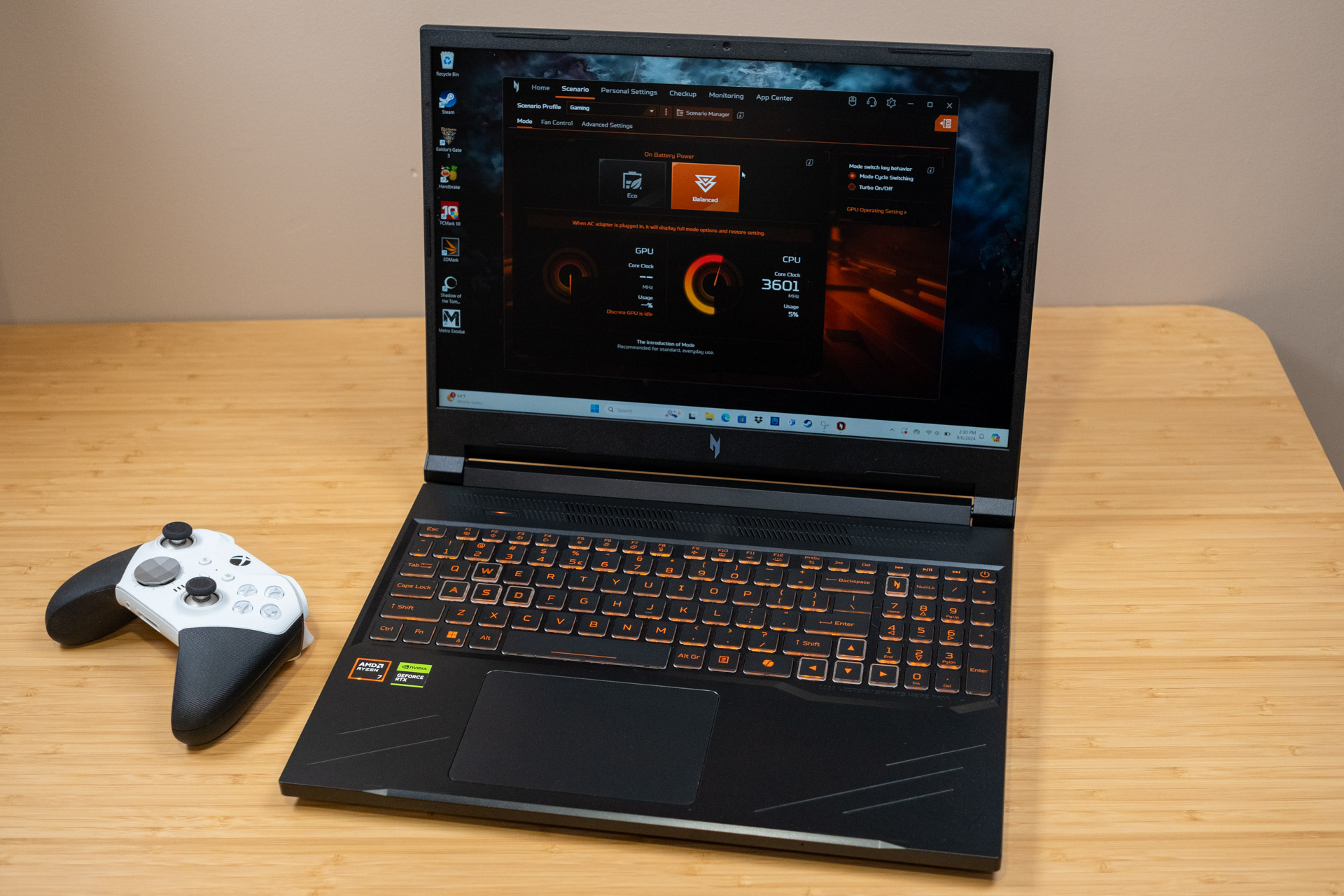
Pros
- Solid performance
- Competitive price
- Dedicated button for quick performance mode switching
- Fast 165Hz display with good colors
Cons
- Fully plastic build
- Mushy keyboard
- Weak battery life
 $969.49
View Deal
$969.49
View Deal
 $1099.99
View Deal
Price comparison from over 24,000 stores worldwide
Product
Price
Price comparison from Backmarket
$969.49 at Amazon$1099.99 at Acer
Why we like the Acer Nitro V 16
$1099.99
View Deal
Price comparison from over 24,000 stores worldwide
Product
Price
Price comparison from Backmarket
$969.49 at Amazon$1099.99 at Acer
Why we like the Acer Nitro V 16
The Acer Nitro V 16 pairs a fast IPS display and RTX 4060 graphics in a package that costs just under a grand, making it the perfect option for the budget-conscious gamer. The GPU is “capable of running any modern game,” according to our review. In fact, while running the built-in Shadow of the Tomb Raider benchmark, the Nitro managed a respectable 136 frames-per-second on average. This result almost matches some gaming laptops with RTX 4070 graphics–impressive! The 16-inch 1920×1200 display isn’t the sharpest, but it’s a step up from the traditional 1080p fare, and the 165Hz refresh rate means you can expect smooth gameplay.
Who should buy the Acer Nitro V 16Anyone who’s looking to save some cash on a reliable gaming laptop. The display is a fine choice for action-packed games because it’s big and fast, and the RTX 4060 GPU is capable of running most games on the Medium or High graphics preset. Battery life, as you might’ve guessed, is subpar (about four hours on a single charge) and the gamer aesthetic is a touch flashy, but if you can live with those trade-offs, then the Acer Nitro V 16 is a fantastic value pick.
Alternative option: The Asus TUF Gaming A16 Advantage Edition ($1,099.99), which was our previous Best Budget Gaming Laptop pick until the Acer Nitro V 16 usurped it, is still a good option to consider. For about a grand, you’re getting reliable graphics performance, a spacious keyboard, and long battery life. If you’re looking for a more subtle-looking gaming laptop, the HP Victus 15 ($1,099.99) might be of interest to you. You’re getting a 144Hz high refresh rate display, a design that doesn’t scream gaming PC, and a 144Hz refresh rate display.
Read our full Acer Nitro V 16 review Asus ProArt P16 – Best content creation laptop
Pros
- Big touchpad with virtual scroll wheel
- Gorgeous 4K OLED display
- More connectivity than the competition
- Good battery life
Cons
- Chassis is light, but doesn’t look remarkable
- CPU performance falls behind the best
- Can get hot under load
 $2269
View Deal
$2269
View Deal
 $2299.99
View Deal
HIDevolution
$2649
View Deal
Price comparison from over 24,000 stores worldwide
Product
Price
Price comparison from Backmarket
$2269 at Amazon$2299.99 at Best Buy$2649 at HIDevolution
Why we like the Asus ProArt P16
$2299.99
View Deal
HIDevolution
$2649
View Deal
Price comparison from over 24,000 stores worldwide
Product
Price
Price comparison from Backmarket
$2269 at Amazon$2299.99 at Best Buy$2649 at HIDevolution
Why we like the Asus ProArt P16
The Asus ProArt P16 is a fantastic pick for creative professionals and prosumers. You’re getting a diverse selection of connectivity options, a stunning 4K OLED display, and great battery life. The 3840×2400 resolution (4K!) display measures 16 inches and features a taller 16:10 aspect ratio. This is a phenomenal display for photo or video editing, as it “boasts an incredible color gamut and deep contrast,” according to our review. The ProArt 16 also lasted over nine hours on a single charge and one of the USB-C ports supports USB 4.0 with data rates up to 40Gbps.
Who should buy the Asus ProArt P16Anyone that likes making content. The Asus Pro Art P16 is the kind of laptop that really pays attention to the finer details. It exhibits the perfect balance of weight, connectivity, and battery life. Although it can get hot under heavier workloads and the aesthetics aren’t much to write home about (it’s just a black slab), it’s still a really good choice for creative folks. The 4K screen is to die for and, despite the powerful internals inside the machine, it somehow manages to weigh only 4.08 pounds.
Read our full Asus ProArt P16 review Asus Zenbook S 14 – Best ultraportable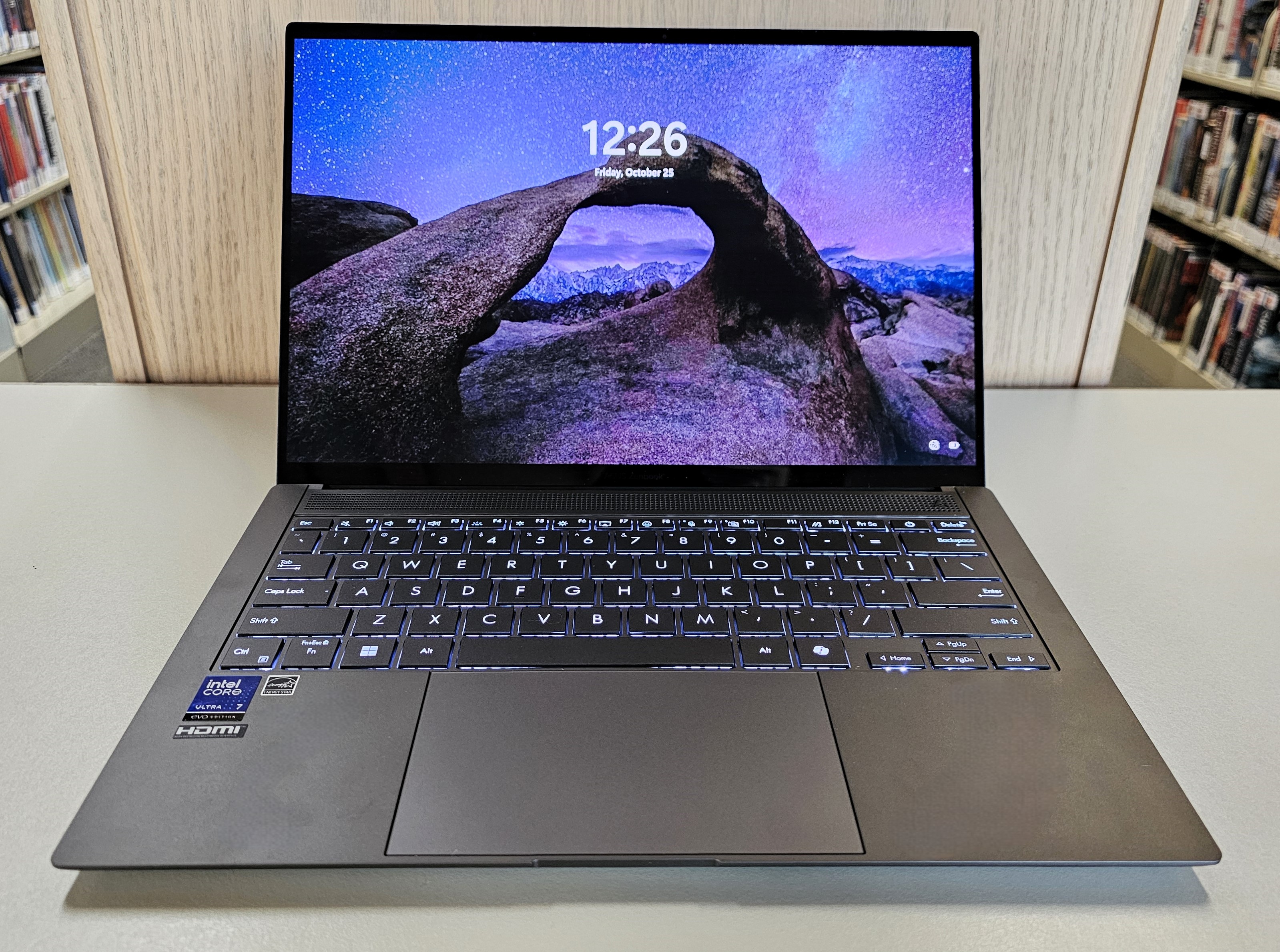
Pros
- Transcendent battery life
- A purposeful use of space
- Lovely, surprisingly large OLED screen
- Great audio
Cons
- Keyboard needs more key travel
- Performance needs improvement, especially on battery
The Asus Zenbook S 14 features a featherlight form factor, incredible battery life, and a beautiful OLED display. It weighs just 2.65 pounds, which is lighter than the 13-inch MacBook Air, and it’s structurally sound as well. According to our review, there was a “minimal amount of flex when pressing hard upon the center of the keyboard and the display doesn’t demonstrate meaningful wobble.” It has somewhat of a ceramic feel to it and the etched silvery lines on the lid give it a unique look.
The 73 watt-hour battery lasted 21 hours on a single charge, which is impressive given how light and compact this laptop is. You don’t ever have to go outlet hunting. The 14-inch 1800p OLED touch display is also lovely, as it’s able to produce richer blacks. The 120Hz refresh rate makes for a smoother inking and mousing experience as well.
Who should buy the Asus Zenbook S 14Anyone who’s looking for a lightweight laptop that just keeps going and going. In addition to the spectacular battery life and the stunning OLED display, the audio is surprisingly good. This is surprising, as laptop speakers tend to be downward-firing, thus muffling the audio. The Zenbook S 14’s audio is boosted by four integrated Harmon Kardon speakers and further enhanced by Dolby Atmos audio. It’s a good laptop to watch movies on, that’s for sure.
Read our full Asus Zenbook S 14 (UX5406SA) review HP OmniBook Ultra Flip 14 – Best 2-in-1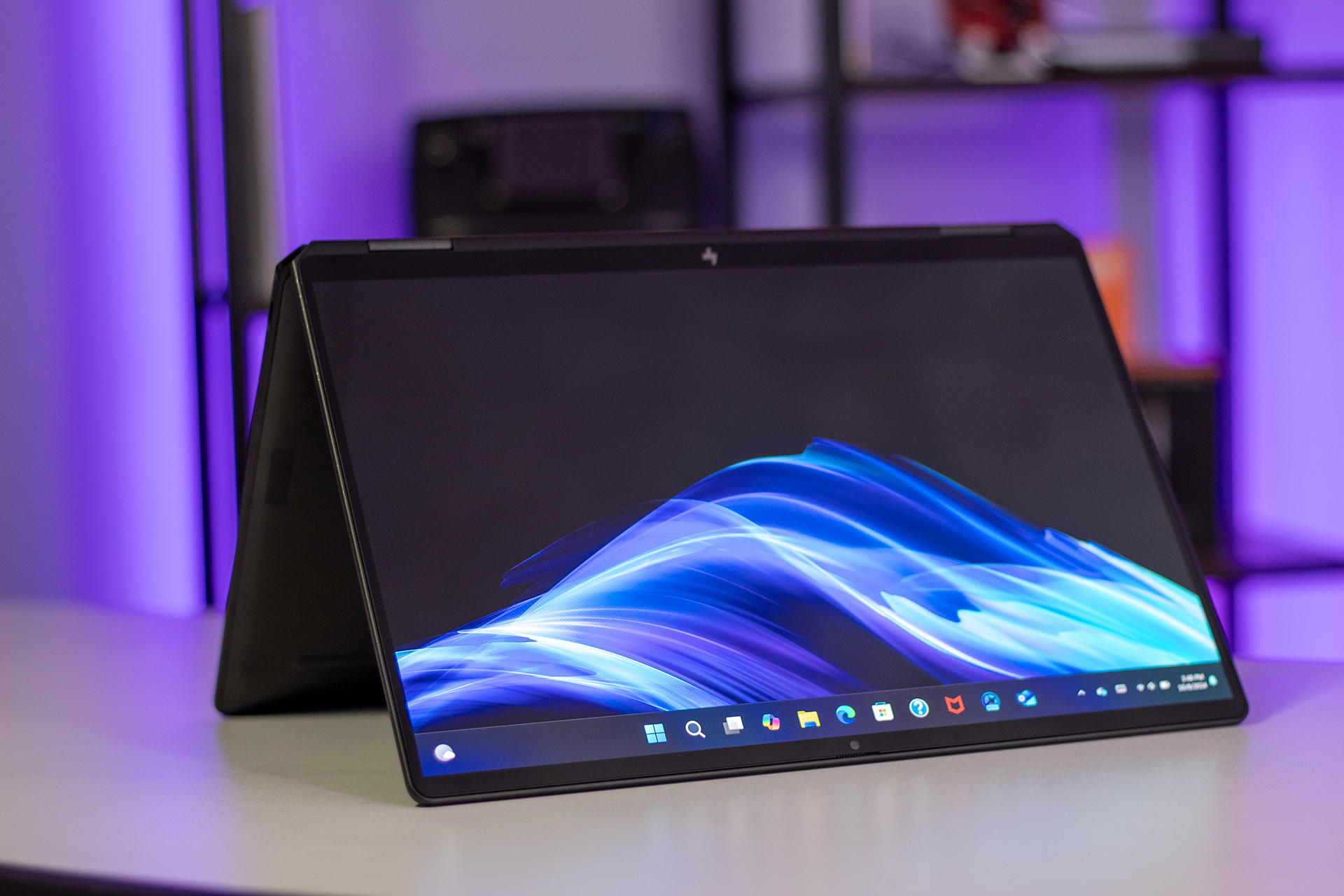
Pros
- OLED touchscreen looks great
- Nice solid build
- Long battery life
Cons
- Few ports in odd spots
- Expensive
 $1599.99
View Deal
$1599.99
View Deal
 $1599.99
View Deal
$1599.99
View Deal
 $1609.99
View Deal
Price comparison from over 24,000 stores worldwide
Product
Price
Price comparison from Backmarket
$1599.99 at Best Buy$1599.99 at HP$1609.99 at Amazon
Why we like the HP OmniBook Ultra Flip 14
$1609.99
View Deal
Price comparison from over 24,000 stores worldwide
Product
Price
Price comparison from Backmarket
$1599.99 at Best Buy$1599.99 at HP$1609.99 at Amazon
Why we like the HP OmniBook Ultra Flip 14
As far as 2-in-1 laptops go, the HP OmniBook Ultra Flip 14 is the complete package. Not only is it well built, but it also boasts epic battery life as well as a comfortable typing experience. It’s not a metal unibody machine, but it feels nice and the 360-degree hinge has the “right amount of stiffness,” according to our review. As for longevity, this laptop lasted 17 and a half hours on a single charge, which is nothing to sneeze at. That’s more than a full school day right there.
Who should buy the HP OmniBook Ultra Flip 14Anyone who’s looking for a long-lasting, well-built 2-in-1 laptop. In addition to the convertible form factor and long battery life, the keyboard offers a comfortable typing experience. The key travel is quite good and the reviewer appreciated the bold lettering on the individual keys. The 14-inch 2880×1800 OLED touch display is another big win for this laptop. It’s bright enough for indoor use (500 nits!) and the black levels are “oh-so inky,” which makes watching movies an absolute joy.
Alternative option: If you’re looking for a more affordable option, the Lenovo IdeaPad 5x 2-in-1 ($849.99) is worth checking out. It features good wired and wireless connectivity as well as a beautiful OLED display and a robust build.
Framework Laptop 13 – Best upgradable option
Pros
- Customizable, repairable, and upgradable
- Choose your own ports
- Detailed repair documentation
- Reasonable Core Ultra performance with solid build quality
- A physical mic shutoff switch
Cons
- On the expensive side for the specs
- Not the best battery life, especially compared to Snapdragon laptops
The Framework Laptop 13 is unique because you can repair, upgrade, or customize any part of it. The hardware is marked with QR codes, which leads you to the individual part on Framework’s website. You can also mix and match the ports–they’re little rectangular blocks (similar to Lego pieces) that snap into the laptop. The whole idea behind this laptop is fun, but practical. You can extend the life of your laptop with something like this.
Who should buy the Framework Laptop 13Anyone that likes to get in there and tinker away. In addition to the upgradability aspect, it’s also pretty light at 2.87 pounds and it churns out respectable CPU performance. It’s not the fastest laptop we’ve ever tested, but office work and day-to-day tasks should be no problem. That said, it’s a little expensive for the hardware, so it may not be the best option for the budget-conscious.
Read our full Framework Laptop 13 review Lenovo Yoga 9i 14 Gen 9 – Best audio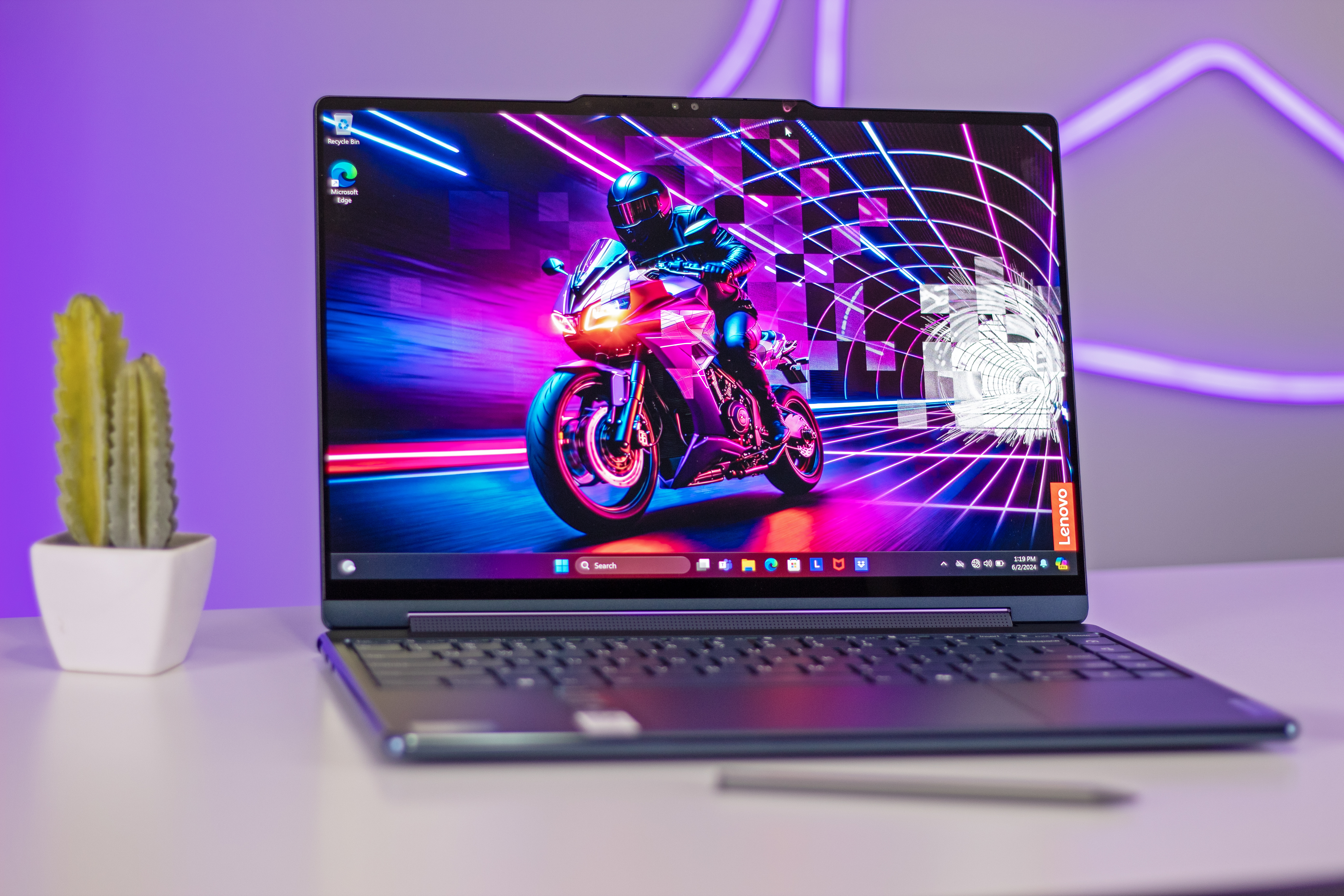
Pros
- Amazing speakers
- Included accessories
- Great display
Cons
- Short on ports
- Cramped keyboard
 $1099.99
View Deal
Lenovo
$1329.30
View Deal
Price comparison from over 24,000 stores worldwide
Product
Price
Price comparison from Backmarket
$1099.99 at Best Buy$1329.30 at Lenovo
Why we like the Lenovo Yoga 9i 14 Gen 9
$1099.99
View Deal
Lenovo
$1329.30
View Deal
Price comparison from over 24,000 stores worldwide
Product
Price
Price comparison from Backmarket
$1099.99 at Best Buy$1329.30 at Lenovo
Why we like the Lenovo Yoga 9i 14 Gen 9
The Lenovo Yoga 9i 14 Gen 9 is a fantastic 2-in-1 laptop with fantastic audio. Generally speaking, most laptop speakers suck. They’re usually poorly placed, so you lose a lot of bass and treble, but that’s not the case with the Lenovo Yoga 9i 14 Gen 9.
The sound bar in the Lenovo Yoga 9i 14 Gen 9 lives in the hinge, so it’s not firing down into whatever surface you’ve got the laptop on. The sound is “impressively loud,” according to our review, and you can even hear the bass and treble at louder volumes. That’s why this laptop is perfect for listening to music or watching movies.
Who should buy the Lenovo Yoga 9i 14 Gen 9Audiophiles and movie buffs! The Lenovo Yoga 9i 14 Gen 9 is a great laptop for consuming media. The sound is great, but so is the OLED touch display, which boasts a 2880×1800 resolution and a 120Hz refresh rate. Black colors are “inky and dark, which makes movies look all the better,” according to our review.
Alternate option: The Dell Inspiron 14 2-in-1 ($949.99) is another good option to consider. In addition to the loud speakers, the Dell Inspiron 14 2-in-1 also has a good selection of ports as well as a satisfactory keyboard.
Read our full Lenovo Yoga 9i 14 Gen 9 review Recent laptop reviews- Lenovo ThinkBook 16 Gen 7: The bargain-priced Lenovo ThinkBook 16 Gen 7 has enough oomph to knock out spreadsheets and video meetings, but it may not hold up to the rigors of travel.
- Asus Vivobook S 14: The Asus Vivobook S 14 combines Intel’s latest Lunar Lake CPU with lots of RAM and storage at a very reasonable price. It’s a nice machine, but Lunar Lake’s multithreaded performance will be a problem for some workloads — and this laptop’s design won’t draw any eyes.
- Dell G15: The “retro-inspired” Dell G15 Gaming Laptop packs a punch in games, but comes with a lot of trade-offs.
- Acer Swift 14 AI: The Acer Swift 14 AI offers solid all-around performance with the latest Snapdragon silicon and a generous selection of ports, but the trackpad is poor and Copilot+ features are still MIA.
- Lenovo IdeaPad 5x 2-in-1: The Lenovo IdeaPad 5x 2-in-1 delivers good bang for the buck.
- Samsung Galaxy Book5 Pro 360: The Samsung Galaxy Book5 Pro 360 is an excellent 2-in-1 laptop with long battery life thanks to Intel’s Lunar Lake hardware. But Lunar Lake’s focus on battery life comes at a cost, and this hardware doesn’t excel at multi-threaded CPU performance.
- Lenovo Chromebook Duet: The 2024 edition of the Chromebook Duet doubles down on its hybrid form factor and budget price. Lenovo has refined this design very well, and it remains a great choice if you want a cheap, reliable Chromebook that fits in small spaces and can do some light tablet duty. Just keep an eye on your tabs.
- Acer Swift 14 AI: The Acer Swift 14 AI isn’t exciting, but it packs well-rounded performance, good battery life, and a nice buffet of connectivity at a reasonable price.
The PCWorld team puts each and every Windows laptop through a series of benchmarks that test GPU and CPU performance, battery life, and so on. The idea is to push the laptop to its limits and then compare it against others we’ve tested. Chromebooks, on the other hand, go through a series of web-based tests. It wouldn’t be fair or possible to run the same kinds of tests on a Chromebook, as they’re Chrome OS-based machines.
Below, you’ll find a breakdown of each test and the reasons why we run them. For a much deeper look at our review methodology, check out how PCWorld tests laptops.
Windows laptops- PCMark 10: PCMark 10 is how we determine how well the laptop handles lighter tasks like web browsing, word processing, spreadsheets, and so on.
- HandBrake: HandBrake is more intensive than PCMark 10. It measures how long a laptop’s CPU takes to encode a beefy 30GB file.
- Cinebench: Cinebench is a brief stress test of the CPU cores. It does this by rendering a 2D scene over a short period.
- 3DMark: 3DMark checks if 3D performance remains consistent over time by running graphic-intensive clips.
- Video rundown test: To gauge battery life, we loop a 4K video using Windows 10’s Movies & TV app until the laptop dies.
- CrXPRT 2: The CrXPRT 2 benchmark tests a Chromebook’s battery life.
- Speedometer 2.0: This test determines a Chromebook’s web browser performance. It simulates this by adding, completing, and removing a to-do list.
- Basemark Web 3.0: This benchmark gauges how well a Chromebook can handle web-based applications.
- Kraken 1.1: Kraken 1.1 is a JavaScript performance benchmark.
- Jetstream 2: Jetstream 2 is a combination of WebAssembly and JavaScript benchmarks. This is a way to gauge how well a Chromebook runs advanced workloads.
The first question you should ask yourself is what kind of laptop you’re looking for. There are traditional clamshells, 2-in-1’s, Chromebooks, and much more. The displays on convertible laptops (aka 2-in-1’s), for example, can swing around 360 degrees. This allows you to use the laptop like a tablet. They can also be propped up like a tent for viewing movies or participating in video calls. Chromebooks, on the other hand, exclusively run Google’s web-focused Chrome OS and are generally used for everyday tasks. All you need is a Gmail account and boom, you’re in. There are pros and cons to each of them. Chromebooks are affordable and generally have good battery life whereas convertibles are normally lightweight and portable.
2. How much processing power do I need in a laptop?If it’s CPU power you’re looking for, look for processors with higher numerical names. A Core i7 is more suited to gaming and more intense work than everyday tasks. Intel processors are available in Core i3, Core i5, Core i7, and Core i9. The higher the number, the more powerful the CPU. If you don’t need a ton of power, Intel Core i5 processors are your best bet, as they offer good performance at a decent price. Basic office and web work get along just fine on a Core i3. As for AMD options, the Ryzen 3 is good for basic productivity and web browsing, while Ryzen 5 chips rival Intel’s Core i5 as solid all-arounders. If you need more power, the Ryzen 7 chip is well suited for content creation like video editing. Finally, if you’re dealing with 4K video, spring for a Ryzen 9.
3. Discrete graphics vs. integrated graphics?You’ll want a discrete graphics card for hardcore gaming or editing videos. It’s separate from the processor, so you can expect higher performance out of it. Integrated graphics, on the other hand, are attached to the CPU and use less power as a result. This is perfectly fine for everyday tasks, especially if you’re not doing anything that’s graphics-intensive.
4. How much memory do I need in a laptop?8GB of RAM is zippy enough for general use. If you’ve got a gaming laptop, 16GB of RAM is the way to go, with 32GB being a future-proof configuration. Content creators will want as much as possible.
5. Do I need a big display on a laptop?If you’re a video editor or someone who does a lot of multimedia work, you’ll want a display that’s anywhere from 15- to 17-inches. The sweet spot is anywhere from 13- to 14-inches, though. The bigger the display, the heavier your laptop is going to be. A 13- or 14-inch display is the best in terms of portability and value.
6. How long should my laptop last on a single charge?If you plan on taking your laptop anywhere with you, aim for something that can last 10 to 12 hours on a single charge. That’s more than a full workday, so it should theoretically get you through long flights or a day of classes. Obviously, more is always better. Just know that the bigger the battery, the heavier the laptop. Read our round-up of the best laptop chargers.
7. How much does a good laptop cost?Many good laptops cost around $500 to $750, but the price really depends on your budget. If you’re strapped for cash (been there, trust me), go for a Chromebook or an entry-level business laptop. You can find solid options for under $500. Spending $750 to $1,000 can get you better displays, additional performance, more storage, and nicer designs. If you splurge for a laptop that costs over $1,000, you’re usually paying up for premium build quality, great extras, and top-shelf performance.
Gaming laptops are different. You can sometimes find gaming laptops with entry-level discrete graphics on sale for around $850, but you’ll usually need to spend at least $1,000 for a system with decent 1080p gaming chops. You can pay more — often much more — for better graphics firepower and nicer displays, but the costs can rise rapidly depending on your hardware of choice. Some fully loaded gaming laptops can go for multiple thousands of dollars but you’re getting the equivalent of a desktop replacement in return. Spending $1,200 to $2,000 usually gets you a very good gaming laptop.
8. Are connectivity options important on a laptop?A wide array of ports is always a plus in my book, as it eliminates the need for an adapter. I’d recommend a laptop that has both USB-C and USB-A. An HDMI port is good, too. This is especially useful when you want to hook up to an external monitor.
